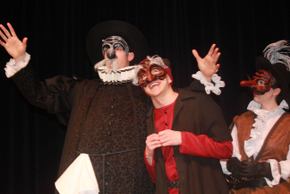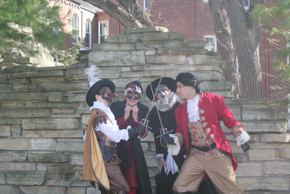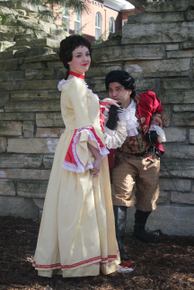Originated in Italy in the 16th Century, the theatrical form commedia dell'arte traditionally finds a group of actors participating in a comedic scenario featuring slapstick conceits called mécanisme. And for his original commedia dell'arte presentation at St. Ambrose University, one fittingly titled Commedia Dell'arte, director Daniel Rairdin-Hale insists that he and his cast have come up with some mécanisme doozies.
"We have one that involves the whole cast running after a coveted object," says Rairdin-Hale. "As someone is running past it, the object gets taken. And then the person who took it gets punched and trips, and it winds up in someone else's hands. And then that person tosses it, and someone else catches it, and then it winds up in someone else's hands. And then it becomes like a baseball game ... .
"It just goes and it goes and it goes and it goes," he continues, "and it's really well-rehearsed. And we're going to fit that into our scenario ... once we know what our scenario is."
Rairdin-Hale mentions this last bit because, as of April 7, his show's enveloping narrative hadn't yet been devised - which wouldn't be at all eyebrow-raising if Commedia Dell'arte weren't opening on April 17. My hunch, however, is that audiences seeing the production should have absolutely no reason to fear a cobbled-together pastiche of commedia dell'arte tropes.
This is partly because Rairdin-Hale has, since his 2009 hiring as a St. Ambrose theatre professor, demonstrated an exquisite gift for directing movement-based theatre, as evidenced by the physicality on display in his productions of Oedipus Rex, A Midsummer Night's Dream, and even this past winter's The Cat in the Hat, a wild, wacky, and largely dialogue-free hour of inspired slapstick mayhem.
It's also partly because Rairdin-Hale has assembled the sort of cast that successful commedia dell'arte demands, with Brooke Schelly, Sam Jones, and others all accomplished actors, musicians, comedians, and now, in the wake of Commedia Dell'arte's demanding workout regimen, even acrobats.
Yet it's mostly because the show's collaborative, ensemble-driven, "making it up as we go along" process is perfectly fitting not only with commedia dell'arte's 16th Century inspirations, but Rairdin-Hale's desire to give his student participants a true sense of that 16th Century experience.
Now, as then, this Commedia Dell'arte troupe is inventing its own comic gambits, which will allow for experimentation, and even improvisation, on a show-by-show basis. Their historically tested material will be peppered with contemporary grace notes. Many in the ensemble will perform in masks. All of them will play live music on stage. And when the production tours - which it will, at local schools and additional area venues, in the week following its St. Ambrose run - the troupe is responsible not only for enacting the show, but setting up and tearing down the stage. (Commedia Dell'arte will also be performed at the Freight House Farmers Market on April 25 and at Davenport Junior Theatre on April 26.)
In short, for both actors and audiences, it's designed to be the complete commedia dell'arte package, and in many ways, the ne plus ultra of Daniel Rairdin-Hale presentations that have given students practical knowledge in movement-based theatre.
"I've always thought it would be fun to do a commedia piece," says Rairdin-Hale, "and when we were talking about possible shows for the season last year, somebody mentioned, 'What if we did Servant of Two Masters, or some other dell'arte piece?' And I had this idea. 'What if we took it a step further and didn't do a commedia script, but actually tried to do our own commedia scenario? What would that look like?'"
 Mind, Body, and Voice
Mind, Body, and Voice
A 2004 graduate of St. Ambrose, Rairdin-Hale says, "My interest in movement-based theatre probably started in earnest with a trip to Dell'Arte International [School of Physical Theatre] in 2003. It's in Blue Lake, California, and I was awarded an opportunity to go there for four weeks over the summer, to study extreme physical theatre. That kind of opened my eyes to mask work, contact improvisation, commedia, statue work ... . Just a whole bunch of different things.
"So when I was looking for a graduate school, I was looking for one that had some mask or movement element," and Rairdin-Hale wound up attending the Theatre School at DePaul University in Chicago, where he earned his MFA.
"DePaul is really big into combining not just vocal and intellectual work," he says, "but also that visceral, 'Chicago style' of acting where you learn to speak with your body. There were whole sections on mask work and clown work and movement without using your face - that neutral mask, neutral mind, neutral body kind of stuff. I loved it."
He went on to stretch his nascent skills in movement- and mask-based theatre in several Chicago productions, one of them Lifeline Theatre's 2007 stage adaptation of The Island of Dr. Moreau, which the Windy City Times called "taut, exciting, and unforgettable," and which Rairdin-Hale calls "a wild time, and a pretty cool mask experience."
In 2010, he also began a professional partnership with the Montreal-based circus artist Audrey Leclair, with whom he formed Du Haut Duo (pronounced "duo duo"), a mostly wordless - and, I can attest, awfully funny - two-person clowning troupe that performed locally last year and recently toured Canada with their show Au Petit Poisson (The Little Fish).
Yet while he has remained immersed in movement-based theatre as a performer, Rairdin-Hale has also, since 2009, relished the chance to share his education and training with students.
"I think that's part of how I got the job," he says. "They saw that I could offer something a little bit different. Even though I got my education here at St. Ambrose, I'm not just teaching what's already been taught. I'm bringing new perspective in from Chicago, from Dell'Arte, and it's been a really good match, I think.
"I mean, it's all connected: the mind, body, and voice," he continues. "It all has to work together. And I think our pieces that are a little bit more physical kind of balance out the pieces that are a little more cerebral, and inform each other. Hopefully, the shows that are more intellectual by nature are also more physical because students have taken a movement class, and the more physical shows are informed by the intellectual work they're getting in acting class."
After Rairdin-Hale's St. Ambrose productions of Oedipus Rex, A Midsummer Night's Dream, and other works, a commedia dell'arte presentation seemed the next logical step in advancing students' understanding of movement-based theatre. And once it was agreed that, instead of staging a previously produced classic, Rairdin-Hale would create his own, debuting celebration of the theatrical form in Commedia Dell'arte, the chief question became: How?
 Creative, Off-the-Wall Stuff
Creative, Off-the-Wall Stuff
"With the Italian troupes of the 1550s," Rairdin-Hale says, "they would've been trained in gymnastics, they would've been musicians, they would've been improvisers ... . They would've had all these skills. They would've had lazzi - these pre-rehearsed comic bits that they would sprinkle in throughout. And they would've built their shows around a scenario that they'd have pinned to a curtain backstage. But they also would've improvised around this scenario, so an audience would never know what was improvised and what was really rehearsed, and it would somehow all flow together."
Consequently, given the show's unusual requirements and there not being a working script for actors to read from, Rairdin-Hale knew he couldn't audition the production in any kind of traditional way.
"So I kind of cast it like a talent show," he says. "Everybody showed me what special skills they had - whether it was baton-twirling or guitar or trombone - and then I cast people based on what they could provide for the show."
"It was like auditioning for a talent show," says Schelly, a St. Ambrose senior whose recent credits include The Importance of Being Earnest and Working. "I'd never been in an audition process quite like that one. Especially not here. Because at St. Ambrose, you come in, you do a monologue, you sing a song, you do cold reads, and you grow to expect that. And then Dan throws this curveball at us ... ."
Laughing, she adds, "The week leading up to auditions, I just remember everyone being like, 'Do I even have a talent? Am I talented? Am I gonna come up with anything?' But of course, everyone did. We had someone come in and do flags that they learned in the marching band, we had people dance, we had singers, someone did a stand-up-comedy thing ... . It was really creative, off-the-wall stuff, and a lot of fun."
Schelly's own audition found her sharing an audition with Jones, a sophomore with whom she performed at Davenport Junior Theatre and in the ComedySportz troupe, and whose own St. Ambrose credits include Monty Python's Spamalot and February's Glengarry Glen Ross.
"I was thinking about the best way to showcase all the talents I thought I could bring to the show," says Jones. "And I'm a singer, I play guitar, and I do improv, so I was like, 'Well, why don't I just combine them?' I was just going to do something on my own, but Brooke asked, 'Can I do that with you?' and so it was like, 'Yeah, let's do a duet. We'll just do it on the spot and see what happens.'
"So we improv-ed a song," he continues. "We decided in advance how we'd do it verse- and chorus-wise, and I strummed on my guitar, and we got a suggestion [from fellow auditionees] on what we'd sing about, and we just did it. It might not have been that great, but I think it was fun."
In the end, Rairdin-Hale was able to cast his show with the traditional roster of commedia dell'arte stock characters: four lovers constituting the innamorati (Alexis Greene, Kayla Lansing, Nevada Nilsson, and Vince Solis); three old men referenced as the vecchi (Jones, Amelia Fischer, and Jackson Green); and the three clowning servants of the zanni (Schelly, Meghan Cessna, and Rachael Pribulsky). And they're not alone.
"We've got some extra zanni in there, 'cause why not?" asks Rairdin-Hale with a laugh. "And in the traditional troupes, there wasn't a stage manager. So at our first meeting, I looked at our stage manager Shannon Rourke, and I said, 'You might have to play a part in this, too. Because we're all in this together now, my friend.'"
 Duck Season / Rabbit Season
Duck Season / Rabbit Season
Before rehearsals for Commedia Dell'arte commenced, Schelly says, "There was a rumor going around that there was going to be gymnastics training involved, and none of us were sure what that was going to entail." Over the course of 12 one-hour sessions with instructors at Davenport's Tumble Time, they found out.
Says Schelly, "We basically learned somersaults, cartwheels, round-offs, front handsprings, back handsprings, front tucks, back tucks, dive rolls, bridge kick-overs, handstands, walking handstands, walking bridges ... . Everything. They crash-coursed us on stuff that the younger kids would learn over years. And some of us took to it really well. There are a couple people in the cast that can do standing front flips and backflips now.
"I'm not one of them," she adds with a laugh. "My cartwheel on my right side is good. My cartwheel on my left side should stay in the closet. But it was a lot of fun. And I can do a handstand without using a wall anymore, which is really exciting."
Rairdin-Hale also gave his cast a crash-course on juggling, and according to Jones, "Now everyone can juggle a little bit. I was the worst one by far. There were times we'd be juggling and I'd just be sitting there throwing the balls, because I just couldn't figure it out. But then at rehearsal one night I was just messing around trying, and all of a sudden I was like, 'Oh my gosh, I can do it!' It was nuts.
"That's one of the great things about this show," Jones continues. "It's really cool to get the opportunity to learn all this stuff. Things I can put on my résumé, and that I can maybe bring to other shows in the future and say, 'This is something I learned at St. Ambrose University.'"
Many of Commedia Dell'arte's cast members are also enjoying their first experiences with the challenging presentational style of masked performance.
"A big part of the training," says Rairdin-Hale, "is translating the lines and textures that you see on the mask into the lines and textures of your body. You start with a neutral palette, and then put this mask on and let it live through your body. So there's a lot of time spent adjusting your own physicality based on what you see with the mask in the mirror, and the eyes you see looking through. Because once the mask is on, they're not your eyes anymore - they're the mask's."
"You basically had to learn how to re-discover your body from infancy," says Schelly of mask training. "How everything moves, how to move your fingers and your wrists, so that we could be these entirely neutral characters. Because once we got rid of, like, the specific gait in our walk, and had this 'neutral body,' we got the masks specific to our characters and could figure out how our characters stand, or how our characters walk. It was really cool - really starting from the ground up."
In conjunction with the acrobatics and mask training, rehearsals have found Rairdin-Hale's cast devising lazzi, the comic gambits that compose much of a traditional commedia dell'arte presentation, and that audiences are likely familiar with whether they know it or not.
"You often find them in cartoons," he says. "Like when Bugs Bunny says, 'It's duck season!' and Daffy Duck says, 'It's rabbit season!', and they go on like that, and then one of them switches, and then the other one switches ... . That's a lazzi.
"Or if you're beating somebody with a bat," he continues, demonstrating with an invisible bat, "and you say, 'I'm going to hit you 10 times! One! [swat] Two! [swat] Three! [swat] Wait ... what comes after three ... ? Oh, right! Four! One! [swat] Two! [swat] Three! [swat] Four! [swat]' And you keep going. These are lazzi that have been around forever. So we're doing some of these, but also inventing our own based on everyone's own skills."
 Milk It
Milk It
Many of those skills are of a musical nature, and St. Ambrose's Commedia Dell'arte will find its entire cast of principals performing songs and dances, and playing musical instruments.
"We have some Renaissance dances and a couple of Italian folk songs sprinkled in," says Rairdin-Hale. "But it won't just be Renaissance music. My argument is, 'Well, if they were using contemporary songs back then to be popular, then maybe we should use contemporary songs to be popular today.'"
(Says Jones with a grin, revealing no particulars, "Yeah, there just might be a few songs in there that are popular nowadays. It'll definitely be fun.")
"There will also be some more contemporary references," Rairdin-Hale adds, "so that today's audience gets that experience of 'Okay, I can connect to these characters. I can connect to these jokes, It's not just a museum piece. It's a museum that's come to life and is engaging with me actively, now, where I live, in this moment.'"
And while, as of April 7, the Commedia Dell'arte participants still didn't know exactly what their show's scenario would be, that only seems to enhance Schelly's and Jones' enthusiasm for the project.
"I'm so excited about it," says Schelly. "It's intimidating, because we have yet to put it all together from start to finish. But we have all these lazzi that we've rehearsed, and all this gymnastics, and the improv aspect of it ... . There's so much that's awesome about this show, there's no reason I wouldn't want to do it."
"I love doing new things in theatre," says Jones. "Love it. And yeah, not having a solidified plan for the whole show is a bit nerve-racking. But because of ComedySportz, I know what it's like to go into a show and not know what's going to happen. I still get nervous, like really nervous, but not knowing what's going to happen is what makes it exciting."
Besides, even after the cast has its finalized scenario for Commedia Dell'arte, that doesn't preclude the show from changing on a show-by-show basis.
"We've been talking a lot about not just ad-libbing, but ad libitum," says Rairdin-Hale. "Basically, in commedia, it means, 'Gauge your audience, and if it's not working, do something else. And if it is working, milk it.'"
He laughs. "So from night to night, audiences might get a slightly different show. It'll still be the same commedia show with the same characters, and with the same songs and comic bits. But it can change depending on how things are going. We might take one lazzi out and put in another, or we might change the scenario a little bit but keep most of the same comic bits. And we have some improvisers in the group, especially, who are going to be really comfortable with that. Everyone's on-board with knowing it may change a little bit from night to night.
"And when we tour," says Rairdin-Hale, "it'll have to change. Because sometimes we're in smaller spaces than we have at St. Ambrose, and sometimes we only have 50 minutes instead of the show's 80 to 85, so that'll mean taking out some subplots or other things ... . We'll kind of have to re-invent the show overnight and then do it.
"So it's exciting and terrifying. And that's how I've felt about a lot of the most rewarding work I've done. I felt that way about Oedipus, and I feel that way about this. It's going to be excellent." After a lengthy pause, he laughs and adds, "Or at least I hope so."
Following its St. Ambrose performances, Commedia Dell'arte will tour Davenport North High School on April 20, Davenport West and Central High Schools on April 21, North Scott and Pleasant Valley High Schools on April 22, and the Creative Arts Academy of the Quad Cities on April 24.
Commedia Dell'arte will also be presented in two additional public performances: At the Freight House Farmers Market (421 W. River Drive, Davenport) on Saturday, April 25 at 10 a.m., and at Davenport Junior Theatre (2822 Eastern Avenue) on Sunday, April 26 at 1 p.m.; donations at the latter performance will be split between Junior Theatre and St. Ambrose University.
Running April 17 through 19, Commedia Dell'arte will be performed at St. Ambrose University's Galvin Fine Arts Center (2101 Gaines Street, Davenport) on Friday and Saturday at 7:30 p.m., and Sunday at 3 p.m. For information and tickets, call (563)333-6251 or visit SAU.edu/theatre.








